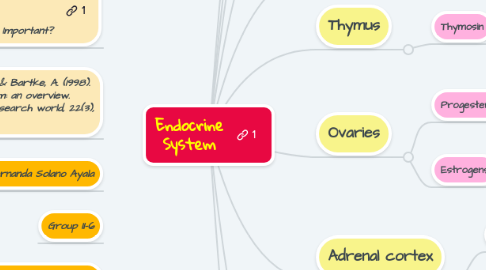
1. Eldrige, L., & Fogoros, R. (2019, June 29). An Overview of the Thymus Gland. Retrieved April 26, 2020, from What Is the Thymus Gland and Why Is It Important?
2. Hiller-Sturmhöfel, S., & Bartke, A. (1998). The endocrine system: an overview. Alcohol health and research world, 22(3), 153.
3. María Fernanda Solano Ayala
4. Group II-6
5. Thyroid
5.1. Thyroid hormone: thyroxine or tetraiodothyronine (T 4 ) and triiodothyronine (T 3)
5.1.1. Increases metabolic rate and production of body heat, influencing both physical and mental activities; required for normal growth.
5.2. Calcitonin
5.2.1. Decreases calcium level in blood.
6. Parathyroid
6.1. Parathyroid hormone
6.1.1. Regulates exchange of calcium between blood and bones; increases calcium level in blood.
7. Adrenal medulla
7.1. Epinephrine and norepinephrine
7.1.1. Active in response to stress; increases respiration, blood pressure, and heart rate.
8. Pancreatic isles
8.1. Glucagon
8.1.1. Stimulates liver to release glucose, thereby increasing blood sugar levels.
8.2. Insulin
8.2.1. Aids transport of glucose into cells; required for cellular metabolism of foods, especially glucose; decreases blood sugar levels.
9. Testicles
9.1. Testosterone
9.1.1. Stimulates growth and development of sexual organs plus development of secondary sexual characteristics; stimulates maturation of sperm cells.
10. Thymus
10.1. Thymosin
10.1.1. Important in development of T cells needed for immunity and in early development of lymphoid tissue.
11. Ovaries
11.1. Progesterone
11.1.1. Stimulates development of secretory parts of mammary glands; preparees uterine lining for implantation of fertilized ovum; aids in maintaining pregnancy.
11.2. Estrogens
11.2.1. Stimulates growth of primary sexual organs and development of secondary sexual characteristics
12. Adrenal cortex
12.1. Cortisol
12.1.1. Aids in metabolism of carbohydrates, proteins and fats; active during stress.
12.2. Sex hormones
12.2.1. Aids in regulating electrolytes and water balance.
13. Anterior pituitary
13.1. GH (Growth hormone)
13.1.1. Promotes growth of all body tissues.
13.2. TSH (Thyroid-stimulating hormone)
13.2.1. Stimulates thyroid gland to produce thyroid hormones.
13.3. FSH (Follicle-stimulating hormone)
13.3.1. Stimulates growth and hormone activity of ovarian follicles; stimulates growth of testes; promotes development of sperm cells.
13.4. LH (Luteinizing hormone)
13.4.1. Causes development of corpus luteum.
13.5. ACTH (Adrenocorticotropic hormone)
13.5.1. Stimulates adrenal cortex to produce cortical hormones; aids in protecting body in stress situations (injury, pain).
13.6. PRL (Prolactin)
13.6.1. Stimulates secretion of milk by mammary glands.
14. Posterior pituitary
14.1. ADH (Antidiuretic hormone; vasopressin)
14.1.1. Promotes reabsorption of water in kidney tubules; stimulates smooth muscle tissue of blood vessels to constrict.
14.2. Oxitocin
14.2.1. Causes contraction of uterus; causes ejection of milk from mammary glands.
